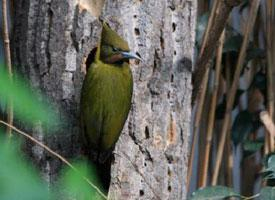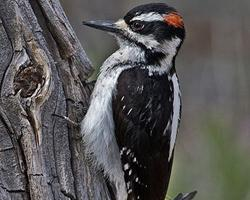
Description de l'animal
The Greater Yellownape (Chrysophlegma flavinucha) is a captivating species of woodpecker native to the lush forests of Southeast Asia. This striking bird is easily recognizable by its distinctive coloration and size, making it a fascinating subject for birdwatchers and nature enthusiasts alike.Sporting a robust body that can reach lengths of up to 35 cm, the Greater Yellownape is among the larger species of woodpeckers. Its plumage is primarily a deep, olive green, which provides excellent camouflage against the dense foliage of its forest habitat. What sets this bird apart, however, is the vibrant yellow nape at the back of its neck, from which it derives its common name. This bright patch of color contrasts beautifully with the bird's otherwise muted tones and is a key identifier of the species.
Both male and female Greater Yellownapes possess this yellow nape, though males can be distinguished by a striking red patch on their cheeks, adding further to their colorful appearance. Their beaks are strong and chisel-like, perfectly adapted for their wood-boring diet. These birds are adept at excavating tree trunks in search of insects, larvae, and occasionally, sap, showcasing their important role in the ecosystem as both predator and pollinator.
The Greater Yellownape is a versatile inhabitant of various forest types, including deciduous, evergreen, and even plantations. Its range spans across several countries, from the Indian subcontinent through to Southeast Asia, encompassing Bhutan, Cambodia, China, India, Indonesia, Laos, Malaysia, Myanmar, Nepal, Thailand, and Vietnam. Despite its wide distribution, the species prefers areas with abundant mature trees, which provide both food and nesting sites.
Breeding season sees these woodpeckers carving out nest cavities in tree trunks, a task that can take several weeks. Both parents share in the incubation duties, and the young are altricial, meaning they are born in a relatively undeveloped state and require significant parental care before they can leave the nest.
The call of the Greater Yellownape is another notable characteristic, consisting of a series of loud, laughing notes that resonate through the forest. These vocalizations serve various purposes, including communication between mates, signaling distress, and marking territory.
Despite their adaptability, Greater Yellownapes face threats from habitat destruction and fragmentation due to logging, agriculture, and urban expansion. While the species is currently listed as Least Concern by the IUCN Red List, its reliance on mature forests underscores the importance of conservation efforts to preserve these critical habitats.
In conclusion, the Greater Yellownape is a vibrant and integral part of Southeast Asia's forest ecosystems. Its distinctive appearance, fascinating behaviors, and the role it plays in maintaining the health of its habitat make it a symbol of the rich biodiversity found in this part of the world. Conservation efforts to protect its environment are crucial in ensuring that future generations can continue to marvel at this colorful woodpecker and the complex ecosystems it inhabits.
Animaux similaires
Nouvelles photos d'animaux
Top 10 des animaux
- Dolphin gull (Leucophaeus scoresbii)
- Diana monkey (Cercopithecus diana)
- Moustached guenon (Cercopithecus cephus)
- Galápagos tortoise (Geochelone nigra complex)
- Stone loach (Barbatula barbatula)
- Japanese macaque (Macaca fuscata)
- Russian tortoise (Testudo horsfieldii)
- Greek tortoise (Testudo graeca)
- Common flying dragon (Draco volans)
- Vendace (Coregonus albula)


